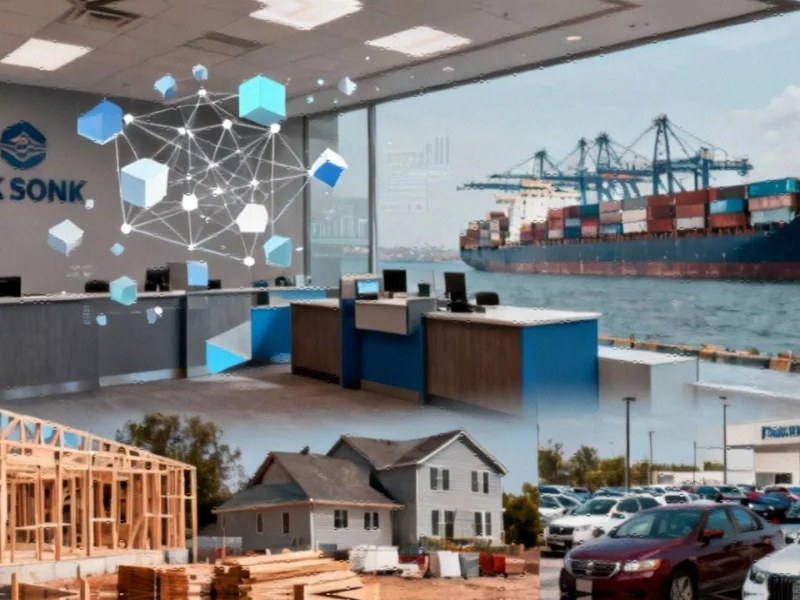Note: Featured image is for illustrative purposes only and does not represent any specific product, service, or entity mentioned in this article.
Economic Vigilance: The Banking Sector’s Multi-Faceted Approach
As financial institutions navigate increasingly complex economic waters, bankers are deploying sophisticated monitoring systems that extend far beyond traditional metrics. The recent volatility in bank stocks has accelerated this scrutiny, pushing analysts to examine both conventional indicators and emerging data points that might signal shifting economic currents.
While public-facing optimism remains a banking industry hallmark—crucial for maintaining economic confidence—internal assessments reveal heightened attention to specific stress indicators. “What we’re seeing is a more nuanced approach to economic forecasting,” explains a senior risk analyst at a major financial institution. “Banks are looking at everything from consumer behavior patterns to supply chain disruptions, creating a mosaic of economic health that’s more detailed than ever before.”
The Core Indicators: Traditional Metrics Still Matter
Despite the evolution in monitoring techniques, traditional economic indicators continue to form the foundation of banking sector analysis. Loan delinquency rates, credit card utilization patterns, and small business lending activity remain crucial barometers. Recent data suggests particular attention to commercial real estate portfolios and consumer credit quality, both showing subtle but concerning shifts.
According to recent banking sector analysis, institutions are implementing more frequent stress testing and scenario modeling. This intensified scrutiny comes as banks balance regulatory requirements with the need for proactive risk management in an uncertain economic landscape.
Sector-Specific Vulnerabilities Coming Into Focus
Bank monitoring has revealed distinct patterns across different industries. The auto financing sector has demonstrated particular softness, with lengthening loan terms and rising inventories suggesting consumer pressure. Similarly, residential construction has shown unexpected sluggishness despite demographic trends that would typically support growth.
These sector-specific challenges reflect broader environmental and economic pressures that are reshaping business fundamentals across multiple industries. Banking analysts note that such cross-sector impacts require more sophisticated modeling to accurately assess portfolio risk.
Geopolitical Factors and Their Economic Ripple Effects
Trade policies and tariff implementations have emerged as significant variables in economic forecasting. Banks are closely tracking how these policies affect client cost structures, particularly for manufacturing and import-dependent businesses. The cascading effects through supply chains create complex challenges for risk assessment.
These international dimensions are further complicated by global environmental changes that increasingly influence economic stability. Banking institutions are developing specialized teams to monitor these interconnected risks and their potential impact on credit quality.
Technological Infrastructure and Monitoring Capabilities
The ability to process vast datasets has transformed how banks identify economic trouble spots. Advanced computing systems enable real-time analysis of transaction patterns, supply chain disruptions, and consumer behavior shifts. This technological edge allows for earlier detection of potential economic stress points.
Recent technological innovations in data processing have significantly enhanced banks’ predictive capabilities. These systems can identify subtle patterns that might escape conventional analysis, providing crucial early warnings about emerging economic challenges.
Forward-Looking Assessment and Strategic Positioning
Beyond immediate risk management, banks are increasingly focused on positioning for various economic scenarios. This involves not just defensive measures but identifying opportunities that might emerge during periods of economic transition. The institutions that successfully navigate current uncertainties will likely be those with the most sophisticated and comprehensive monitoring frameworks.
As with other sectors facing complex operational challenges, financial institutions must balance multiple competing priorities while maintaining stability and confidence. The current environment represents both a test of existing systems and an opportunity to develop more resilient economic assessment methodologies.
The Human Element in Economic Forecasting
Despite advances in data analytics, experienced judgment remains crucial in economic assessment. Seasoned bankers emphasize the importance of contextual understanding that complements quantitative analysis. “The numbers tell part of the story,” notes a chief economist at a regional bank, “but understanding the narrative behind those numbers—the why, not just the what—separates effective forecasting from simple data reporting.”
This balanced approach, combining technological capability with human expertise, represents the banking sector’s best defense against unexpected economic turbulence. As credit quality concerns persist, this comprehensive monitoring framework will continue to evolve, incorporating new data sources and analytical techniques to better anticipate economic challenges before they become crises.
This article aggregates information from publicly available sources. All trademarks and copyrights belong to their respective owners.



